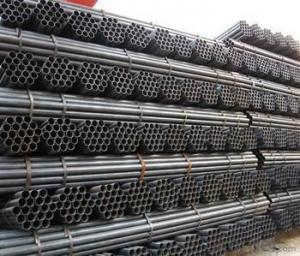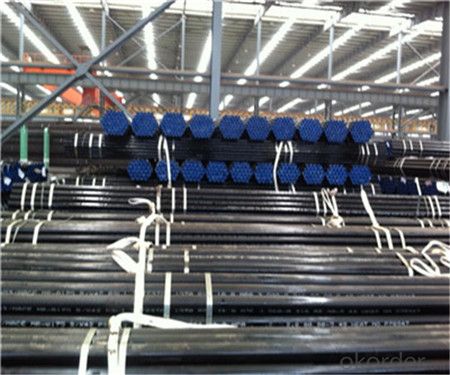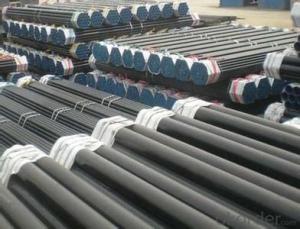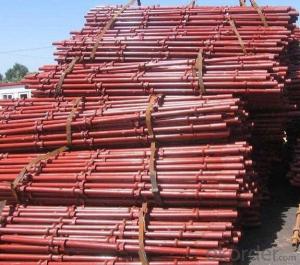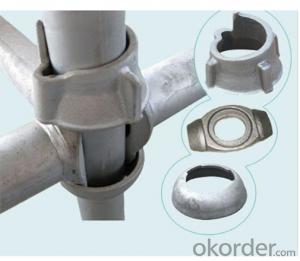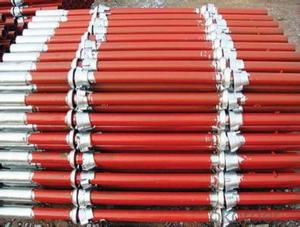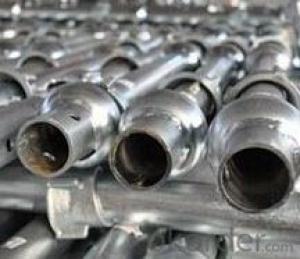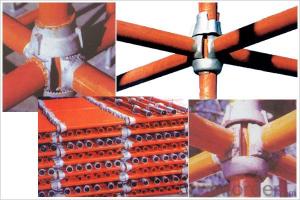BS1387 ,Q235,Scaffolding Steel Pipe High Quality
- Loading Port:
- Tianjin
- Payment Terms:
- TT or LC
- Min Order Qty:
- 20 m.t.
- Supply Capability:
- 15000 m.t./month
OKorder Service Pledge
OKorder Financial Service
You Might Also Like
1、Structure of BS1387 ,Q235,Scaffolding Steel Pipe High Quality:
Seamless pipe is formed by drawing a solid billet over a piercing rod to create the hollow shell. As the manufacturing process does not include any welding, seamless pipes are perceived to be stronger and more reliable. Historically seamless pipe was regarded as withstanding pressure better than other types, and was often more easily available than welded pipe.
2、Main Features of BS1387 ,Q235,Scaffolding Steel Pipe High Quality:
• High manufacturing accuracy
• High strength
• Small inertia resistance
• Strong heat dissipation ability
• Good visual effect
• Reasonable price
3、BS1387 ,Q235,Scaffolding Steel Pipe High Quality Specification:
Standard | GB, DIN, ASTM ASTM A106-2006, ASTM A53-2007 |
Grade | 10#-45#, 16Mn 10#, 20#, 45#, 16Mn |
Thickness | 8 - 33 mm |
Section Shape | Round |
Outer Diameter | 133 - 219 mm |
Place of Origin | Shandong, China (Mainland) |
Secondary Or Not | Non-secondary |
Application | Hydraulic Pipe |
Technique | Cold Drawn |
Certification | API |
Surface Treatment | factory state or painted black |
Special Pipe | API Pipe |
Alloy Or Not | Non-alloy |
Length | 5-12M |
Outer Diameter | 21.3-610mm |
Grade | 20#, 45#, Q345, API J55, API K55, API L80, API N80, API P110, A53B |
Standard | ASME, ASTM |
1) Material:20#(ASTM A 106/A53 GRB.API5LGRB,GB),45#,16Mn,10#.
2) Specification range:OD:21.3-610mm,WT:6-70mm,length:6-12m or according to the requirement of clients.
3) Excutive standards:GB,ASME API5L.ASTM A 106/A53,Despite of the above standards,we can also supply seamless steel pipe with standard of DIN,JIS,and so on,and also develop new products according to the requirements of our clients!
4) Surface:black lacquered,varnish coating or galvanized.
5) Ends:Beveled or square cut,plastic capped,painted.
6) Packing:bundles wrapped with strong steel strip,seaworthy packing.
4、Packaging & Delivery
Packaging Details: | seaworthy package,bundles wrapped with strong steel strip |
Delivery Detail: | 15-30days after received 30%TT |
5、FAQ of BS1387 ,Q235,Scaffolding Steel Pipe High Quality:
①How is the quality of your products?
Our products are manufactured strictly according to national and internaional standard, and we take a test
on every pipe before delivered out. If you want see our quality certifications and all kinds of testing report, please just ask us for it.
Guaranteed: If products’ quality don’t accord to discription as we give or the promise before you place order, we promise 100% refund.
②How about price?
Yes, we are factory and be able to give you lowest price below market one, and we have a policy that “ for saving time and absolutely honest business attitude, we quote as lowest as possible for any customer, and discount can be given according to quantity”,if you like bargain and factory price is not low enough as you think, just don’t waste your time.Please trust the quotation we would give you, it is professional one.
③Why should you chose us?
Chose happens because of quality, then price, We can give you both.Additionally, we can also offer professional products inquiry, products knowledge train(for agents), smooth goods delivery, exellent customer solution proposals.Our service formula: good quality+good price+good service=customer’s trust
SGS test is available, customer inspection before shipping is welcome, third party inspection is no problem.
6、BS1387 ,Q235,Scaffolding Steel Pipe High Quality Images:
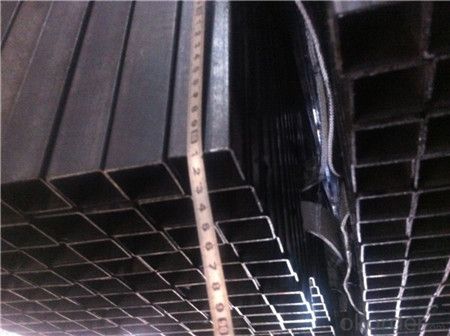
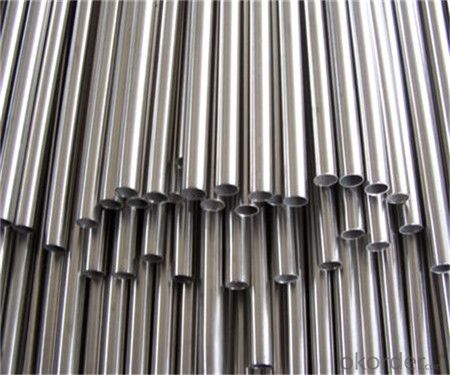
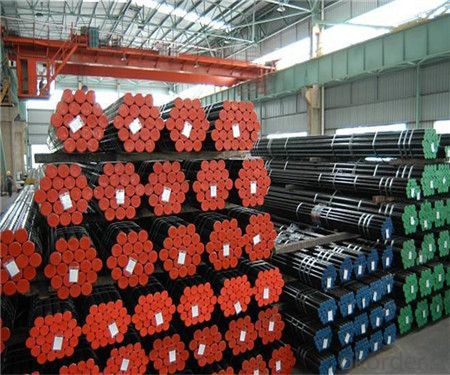
- Q: How are steel pipes coated for protection against external elements?
- Steel pipes are coated for protection against external elements through various methods, such as hot-dip galvanizing, epoxy coating, or fusion-bonded epoxy coating. These coatings provide a barrier between the steel and the environment, preventing corrosion and extending the lifespan of the pipes.
- Q: How are steel pipes used in the construction of railways?
- Steel pipes are used in the construction of railways for various purposes such as laying tracks, supporting structures, drainage systems, and carrying utilities like water and electrical cables. They provide strength, durability, and corrosion resistance, ensuring the smooth functioning and longevity of railway infrastructure.
- Q: How are steel pipes tested for quality control?
- Steel pipes are tested for quality control through various methods such as visual inspection, dimensional checks, non-destructive testing, and mechanical testing. These tests ensure that the pipes meet the required standards and specifications, ensuring their structural integrity and performance.
- Q: Can steel pipes be used for conveying sewage sludge?
- Indeed, sewage sludge can be conveyed using steel pipes. Steel pipes possess several properties that render them suitable for this purpose. Firstly, their strength and durability enable them to endure the pressure and weight of sewage sludge without collapsing or fracturing. This is of utmost importance as sewage sludge can be quite heavy and may contain solids that could exert stress on the pipes. Secondly, steel pipes exhibit resistance to corrosion, which is crucial when conveying sewage sludge that frequently contains corrosive components. By utilizing corrosion-resistant steel pipes, one can ensure a prolonged lifespan and minimize the risk of leaks or damage. Moreover, steel pipes can be manufactured in various sizes and diameters, granting flexibility in the design of sewage systems to meet specific requirements. Nonetheless, it is vital to emphasize the necessity of proper maintenance and regular cleaning to prevent sludge buildup and maintain the pipes' efficiency.
- Q: Can steel pipes be used for transporting liquids and gases?
- Indeed, both liquids and gases can be transported using steel pipes. Renowned for their durability, strength, and resistance to corrosion, steel pipes are highly appropriate for various purposes, including the conveyance of fluids and gases. Industries like oil and gas, water supply, sewage systems, and chemical processing plants frequently employ steel pipes due to their reliability and efficiency in transporting liquids and gases across extensive distances. As a result, the transportation of these substances is accomplished securely and efficiently with the aid of steel pipes.
- Q: Are steel pipes suitable for use in hydropower plants?
- Yes, steel pipes are suitable for use in hydropower plants. Steel pipes offer excellent durability, strength, and resistance to corrosion, making them ideal for transporting water or other fluids in hydropower systems. Additionally, steel pipes can withstand high pressure and provide efficient flow rates, ensuring reliable and efficient operation of the hydropower plant.
- Q: How are steel pipes used in the telecommunications industry?
- Steel pipes are commonly used in the telecommunications industry for the installation of underground and overhead cables. These pipes provide a protective casing for the cables, ensuring their safety from external elements and physical damage. Additionally, steel pipes are used in the construction of telecommunication towers and infrastructure, providing support and stability for antennas, satellite dishes, and other communication equipment.
- Q: How are steel pipes tested for pressure and leakage?
- To ensure the safety and reliability of steel pipes, various methods are employed to test them for pressure and leakage. Hydrostatic testing is a commonly used technique, whereby the pipe is filled with water and subjected to a specific pressure for a set period of time. This examination aims to detect any weaknesses or leaks by observing if there is a drop in pressure or visible water leakage. The test carefully monitors and measures the pressure, and if the pipe successfully withstands the required pressure without any signs of leakage, it is deemed to have passed. In addition to hydrostatic testing, other non-destructive methods can also be utilized. Ultrasonic testing, for instance, employs high-frequency sound waves to identify flaws or defects in the pipe material. Similarly, magnetic particle testing involves the application of a magnetic field to the pipe and inspecting it for any magnetic particles that may indicate cracks or imperfections. Furthermore, visual inspection is a crucial component of the pressure and leakage testing of steel pipes. Trained inspectors thoroughly examine both the exterior and interior surfaces of the pipe to detect any visible signs of damage, such as corrosion, cracks, or faulty welds. This visual assessment aids in identifying potential weak points that may lead to leaks or failures under pressure. In summary, a comprehensive evaluation of steel pipes for pressure and leakage involves a combination of hydrostatic testing, non-destructive methods, and visual inspection. These rigorous procedures guarantee that the pipes meet the required standards and are safe for their intended applications.
- Q: What are the different methods of joining steel pipes together?
- There are several methods of joining steel pipes together, each with its own advantages and disadvantages. 1. Welding: This is the most common and widely used method of joining steel pipes. It involves heating the ends of the pipes and applying pressure to fuse them together. Welding provides a strong and durable joint, but it requires skilled labor and specialized equipment. 2. Threaded connections: Steel pipes can also be joined by threading the ends and using threaded fittings to connect them. This method is relatively easy and quick, but it may not be as strong as welding and can be prone to leakage if not properly sealed. 3. Flanged connections: Flanges are used to connect pipes by bolting them together. This method allows for easy disassembly and reassembly, making it suitable for applications that require frequent maintenance or repair. Flanged connections are also highly resistant to leakage. 4. Compression fittings: Compression fittings are used to join steel pipes by compressing a ring or ferrule onto the pipe, creating a tight seal. This method is simple and does not require heat or welding, making it ideal for applications where heat or sparks are not permissible. 5. Grooved connections: Grooved connections involve cutting grooves into the pipe ends and using mechanical couplings to secure them together. This method is fast, reliable, and allows for easy assembly and disassembly. Grooved connections are commonly used in fire protection systems. 6. Brazing: Similar to welding, brazing involves heating the pipe ends and adding a filler material to join them together. This method is often used for smaller diameter pipes and provides a strong joint. However, it requires the use of a high-temperature torch and skilled labor. Each of these methods has its own advantages and is suitable for different applications. The choice of joining method depends on factors such as the required strength, ease of installation, maintenance requirements, and the type of pipe being used.
- Q: How do you calculate the pipe flow velocity for steel pipes?
- To determine the velocity of flow in steel pipes, two equations can be utilized: Manning's formula or the Darcy-Weisbach equation. 1. Manning's formula, commonly applied to open channel flow but also suitable for partially filled pipes, calculates velocity based on the pipe's hydraulic radius, slope, and Manning's roughness coefficient. The formula is as follows: Velocity (V) = (1.486/n) * (R^2/3) * (S^1/2) In this formula: - V represents the velocity - n denotes the Manning's roughness coefficient (obtainable from reference tables) - R signifies the hydraulic radius (cross-sectional area divided by wetted perimeter) - S indicates the slope of the energy grade line 2. The Darcy-Weisbach equation, widely used for pipe flow calculations, derives velocity from the pipe's diameter, roughness coefficient, and head loss due to friction. The equation is as follows: Velocity (V) = (2 * g * hL)^0.5 In this equation: - V represents the velocity - g stands for the acceleration due to gravity (approximately 9.81 m/s^2) - hL refers to the head loss caused by friction, which can be calculated using the Darcy-Weisbach equation: hL = (f * L * V^2) / (2 * g * D) In this equation: - f denotes the Darcy friction factor (dependent on the Reynolds number and pipe roughness) - L represents the length of the pipe - D indicates the diameter of the pipe Both formulas necessitate input parameters such as pipe dimensions, roughness coefficients, and slope. These parameters can be obtained from engineering references or pipe manufacturer specifications. It is essential to note that these formulas provide approximate values and may require iterations or adjustments for precise outcomes.
Send your message to us
BS1387 ,Q235,Scaffolding Steel Pipe High Quality
- Loading Port:
- Tianjin
- Payment Terms:
- TT or LC
- Min Order Qty:
- 20 m.t.
- Supply Capability:
- 15000 m.t./month
OKorder Service Pledge
OKorder Financial Service
Similar products
Hot products
Hot Searches
Related keywords
